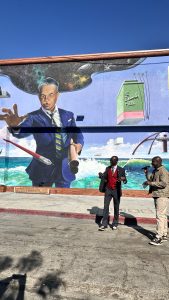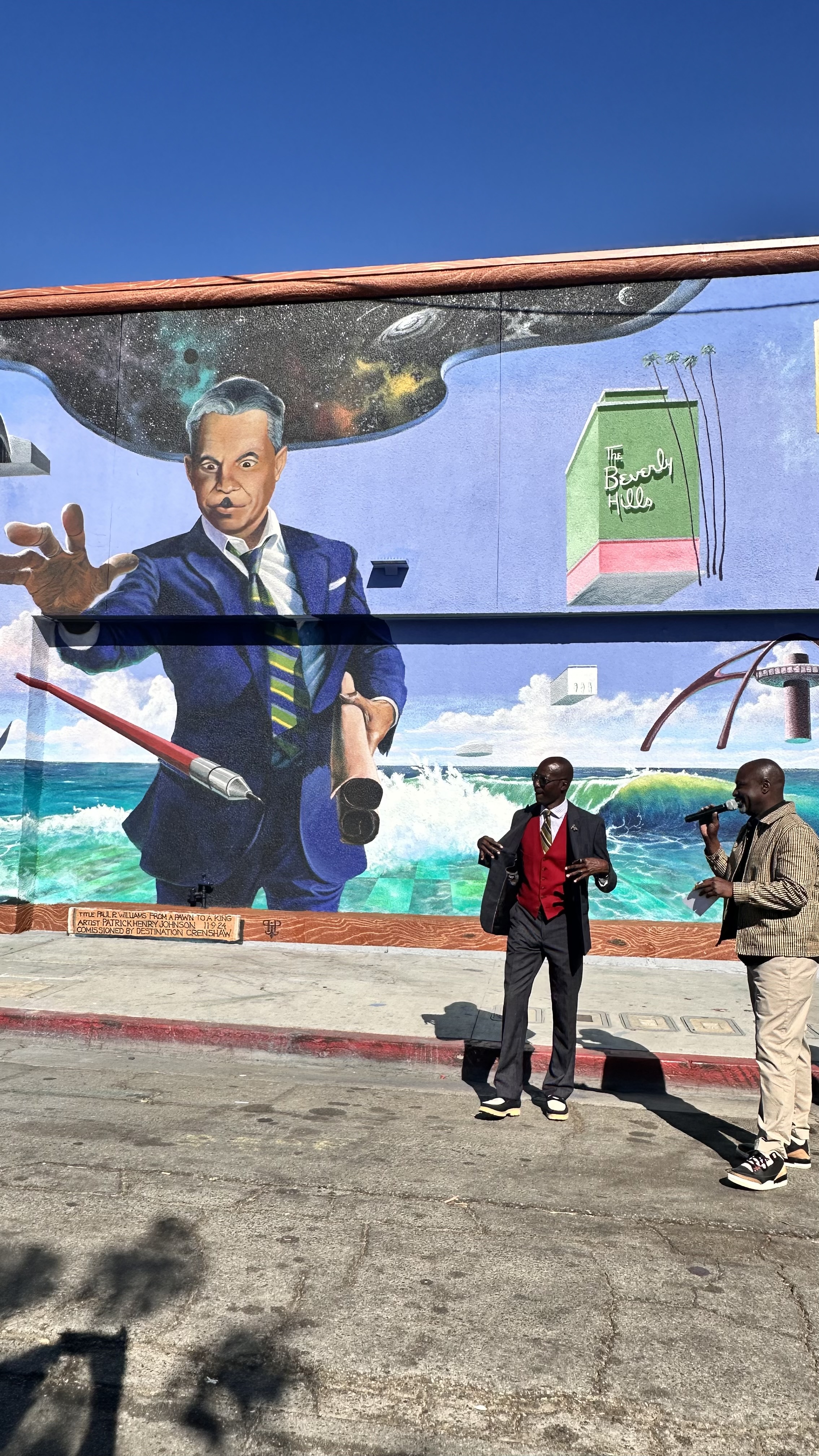
On a crisp, sunny Saturday in South Los Angeles, community members gathered to celebrate an one of the city’s unsung heroes.
The unveiling of Patrick Henry Johnson’s latest mural, “The Pawn Who Became a King,” marks another milestone in the journey of Destination Crenshaw—a powerful movement to preserve and uplift the legacy of Black Los Angeles.
This 75-foot-long mural, located at 5870 Crenshaw Blvd, wraps around the corner of the AutoZone Auto Parts store, paying homage to the legendary architect Paul Revere Williams. Known as LA’s most influential Black architect, Williams broke barriers and redefined what was possible for Black professionals in his field.
Painted in Johnson’s signature Heroic Surrealist style, the mural features Williams surrounded by some of his most iconic designs. His figure reaches out, grasping the architect’s nib that symbolized the tool with which he shaped the city, blending artistry with community impact.
The event was graced by Council President Marqueece Harris-Dawson, who presented Patrick Henry Johnson with a Certificate of Appreciation. In his address, Harris-Dawson emphasized the importance of projects like Destination Crenshaw, especially during times of social unrest.
“The art and design of this project are led by Black women, and many of our key monuments are tributes to Black women. This mural stands as a testament to the brilliance and resilience of our community,” he said.
For Jason Foster, president and CEO of Destination Crenshaw, the day was more than just an unveiling—it was a moment of cultural celebration.
“Projects like this remind us of our power to create spaces of safety, belonging, and pride for Black people in Los Angeles,” Foster remarked.

“The first thing that people see when they emerge from the train is this mural. It’s a statement of who we are, a symbol of resilience and creativity.”
Williams was born in Los Angeles in 1894 and rose to prominence despite the challenges of racial prejudice. A true trailblazer, Williams was the first Black architect to become a member of the American Institute of Architects (AIA) in 1923 and was later inducted as its first Black Fellow in 1957.
His architectural legacy spans nearly six decades, during which he designed over 3,000 structures, including homes for Hollywood icons like Frank Sinatra and Lucille Ball, as well as significant civic and commercial buildings throughout the city.

Gabrielle Bullock, a principal architect on the Destination Crenshaw project, spoke passionately about Williams’ influence on her career.
“Many of us, especially Black architects, never learned about Paul Williams in school,” Bullock admitted.
“But we stand on his shoulders today. His work was not just about buildings; it was about uplifting communities and creating spaces that reflect our dreams and aspirations.”
Born in Valdosta, Georgia, and later establishing his artistic roots in Los Angeles, Patrick Henry Johnson is no stranger to creating powerful public art. Johnson’s works have adorned neighborhoods across L.A. and beyond. His latest masterpiece, “The Pawn Who Became a King,” uses the checkerboard motif — a nod to Williams’ use of patterns in pool designs and interiors.
The mural’s swirling water, dramatic waves, and bold architectural imagery are layered with meaning, representing the complexities of Williams’ journey as a Black architect in a segregated America. At the unveiling, Johnson expressed his gratitude to the community and those who supported him throughout the project.
“Creating this mural was the most fun I’ve ever had on a job,” Johnson shared.
“I was driven by a desire to honor a man who not only shaped the physical landscape of Los Angeles but also inspired generations of Black architects to dream big.”
Johnson’s personal connection to the mural is evident in every brushstroke. “I wanted him to appear dignified yet accessible, someone who reached for greatness despite the odds,” Johnson explained.
“My favorite part of this painting is the water. It symbolizes the fluidity of his genius and the waves of change he created.”
Jordan Adero, Williams’ great-granddaughter, expressed her pride in seeing her ancestor’s contributions recognized in such a profound way.
“My great-grandmother, Mama D, was the backbone of our family, standing by my great-grandfather’s side through all his personal and professional endeavors,” Adero told the Sentinel.
“For this mural to be on Crenshaw Boulevard, in the neighborhood my great-grandfather loved, is such a privilege,” Adero said.
“This is a celebration not just of his legacy but of the spirit of Black Los Angeles. He poured his heart into projects like the 28th Street YMCA, the Golden State Mutual Life Insurance Building, and First AME Church. These places are more than just buildings; they are pillars of our South LA community, reflecting his deep love for this area.”
Trenton Whetstone, a public safety officer who once dreamed of becoming an architect, spoke emotionally about the impact of seeing a Black architect honored in his own community.
“If I had known about Paul Williams when I was younger, my life might have been different,” Whetstone reflected. “This mural shows our young people that there’s a place for them in fields like architecture.”
As Destination Crenshaw moves forward, Jason Foster shared exciting plans for the future, including the completion of additional murals by emerging Black artists and the creation of public spaces that celebrate the rich history of Black Los Angeles.
“This project is about more than art,” Foster shared with the Sentinel.
“It’s about reclaiming our narrative and ensuring that the next generation knows the giants upon whose shoulders they stand.”







